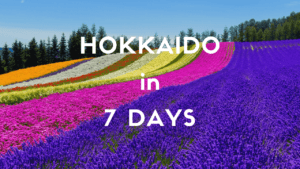Best National Parks in Hokkaido
Explore The Highlights of Hokkaido's National Parks

Hokkaido, the northernmost region in Japan, is a treasure trove of natural splendor and dramatic landscapes. In this vast wilderness, Hokkaido boasts six impressive national parks (out of a total of 32 parks nationwide) where unique sights range from volcanic mountains to crystal-clear lakes. And all of this is preserved and cherished under Japan’s distinctive approach to natural conservation.
Come again? Well, did you know that unlike most western countries, Japan’s National Parks consist of a collective effort involving private and local government lands? Japan’s constrained spaces and a long history of private land ownership has led to an interesting sort of patchwork approach when it comes to protecting these lands, in order to preserve the natural ecosystems and the country’s most beautiful sights.
But enough with the trivia, we’re here to introduce the National Parks you cannot miss in Hokkaido if, like yours truly, you’re an enthusiast of the great outdoors!
Check also: Best National Parks in Japan
1. Daisetsuzan National Park

The park boasts a variety of alpine flora and fauna, including the rare Pika and the Japanese Serow. Its landscapes offer a stunning array of seasonal transformations, from vibrant green summers to colorful autumn foliage and snow-capped peaks in winter. With its pristine hot springs, like those found in Sounkyo Gorge, and the highest peak, Mount Asahidake, Daisetsuzan offers a truly immersive natural experience.
More info: Hiking at Mt Asahi Daisetsuzan National Park, Hokkaido
 Access Access |
Asahikawa Station is the main transportation hub to many areas of the park |
|---|---|
 Official Website Official Website |
http://www.env.go.jp/park/daisetsu/ |
2. Shikotsu-Toya National Park

The crystal-clear waters of Lake Shikotsu, the non-freezing lake surrounded by steep mountains, and the scenic beauty of Lake Toya, with its backdrop of Mount Yotei, often called “Ezo Fuji” for its resemblance to Mount Fuji, make this park a popular destination for both relaxation and adventure.
More info: Lake Shikotsu: The Most Transparent Lake in Hokkaido
 Access Access |
Lake Toya is reachable from Toya Station but overall public transportation services are limited so it’s best to take a seasonal bus tour or go by car. |
|---|---|
 Official Website Official Website |
https://www.env.go.jp/en/nature/nps/park/shikotsu/index.html |
3. Akan-Mashu National Park

Lake Mashu, acclaimed for being one of the clearest lakes in the world, has breathtaking views from its surrounding peaks like Mount Meakan, a local favorite among hiking enthusiasts. The area is also famous for its hot springs and the rich indigenous Ainu culture, providing visitors with a good opportunity to experience both the natural beauty and local cultural heritage.
 Access Access |
Main access areas by private car from Akanko Onsen or Kawayu Onsen as public transportation is limited. |
|---|---|
 Official Website Official Website |
https://www.env.go.jp/park/akan/index.html |
4. Kushiro Shitsugen National Park

The park’s vast marshes offer a unique landscape that changes with the seasons, from lush greenery in summer to a snowy wonderland in winter. Observation platforms and walking trails allow visitors to explore the wetlands and observe wildlife in their natural environment, making it a must-visit for bird watchers and nature enthusiasts.
 Access Access |
JR Senmo Line or bus services from Kushiro City |
|---|---|
 Official Website Official Website |
https://www.env.go.jp/park/kushiro/ |
5. Shiretoko National Park

The coastline is characterized by dramatic cliffs and cascading waterfalls with spectacular views, while the interior’s dense forests and mostly untouched nature trails are a prime spot for hiking and wildlife observation. In winter, the drift ice phenomenon is a unique natural spectacle that attracts visitors from around the world.
More info: Shiretoko National Park: the Great Northeastern Park in Hokkaido
 Access Access |
Access trough Memanbetsu Airport or Nakashibetsu Airport for the two main gateways to the park, Utoro or Rausu respectively |
|---|---|
 Official Website Official Website |
https://www.goko.go.jp/fivelakes/ |
6. Rishiri-Rebun-Sarobetsu National Park
Rishiri-Rebun-Sarobetsu National Park (利尻礼文サロベツ国立公園), designated in 1974, comprises the islands of Rishiri and Rebun, along with the Sarobetsu wetlands at the northernmost edge of Japan. The park is famous for its alpine flora, particularly on Rebun Island, known as the “Floating Island of Flowers”, where rare alpine species thrive at sea level due to the cold ocean currents, creating a unique landscape.
Mount Rishiri, resembling a miniature Mount Fuji, offers challenging hikes with rewarding panoramic views. The Sarobetsu plain is one of Japan’s largest wetlands, providing a habitat for migratory birds and a variety of wetland flora. This park offers a unique blend of mountainous and coastal landscapes, with opportunities for hiking and bird watching while enjoying a uniquely beautiful landscape.
 Access Access |
Access through Wakkanai Port Ferry Terminal to reach Rishiri or Rebun islands |
|---|---|
 Official Website Official Website |
https://www.env.go.jp/park/rishiri/ |
Extra: Hokkaido’s Quasi-National Parks
Hokkaido is also home to five Quasi-National Parks, which are places of natural scenic beauty almost on par with the National Parks:
Onuma Quasi-National Park (大沼国定公園)

Niseko-Shakotan-Otaru Kaigan Quasi-National Park (ニセコ積丹小樽海岸国定公園)

Shokanbetsu-Teuri-Yagishiri Quasi-National Park (暑寒別天売焼尻国定公園)

Hidaka Sanmyaku-Erimo Quasi-National Park (日高山脈襟裳国定公園)

Abashiri Quasi-National Park (網走国定公園)

▽Subscribe to our free news magazine!▽
For more information about traveling in Japan, check these articles below, too!
▽Related Articles▽
▼Editor’s Picks▼
Written by
Photographer, journalist, and avid urban cyclist, making sense of Japan since 2017. I was born in Caracas and lived for 14 years in Barcelona before moving to Tokyo. Currently working towards my goal of visiting every prefecture in Japan, I hope to share with readers the everlasting joy of discovery and the neverending urge to keep exploring.














